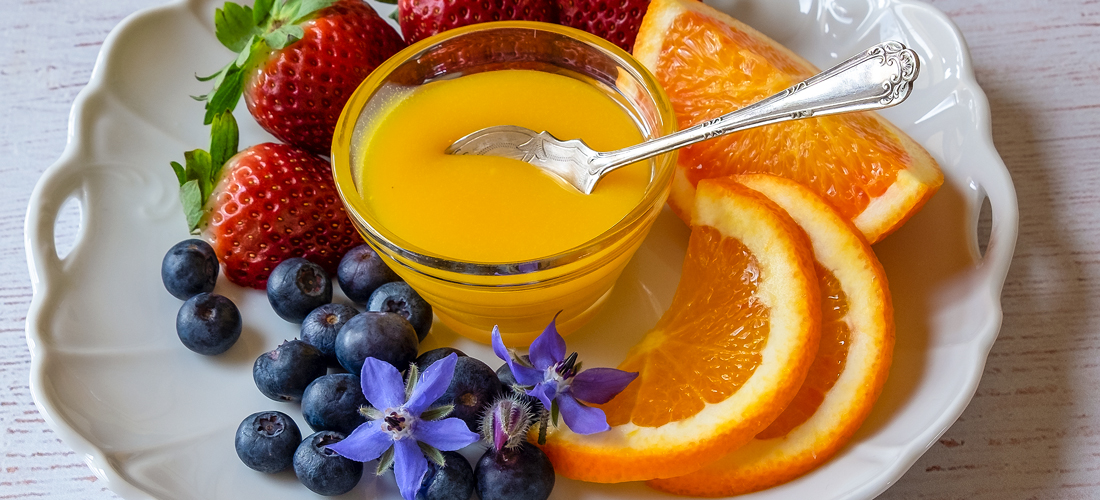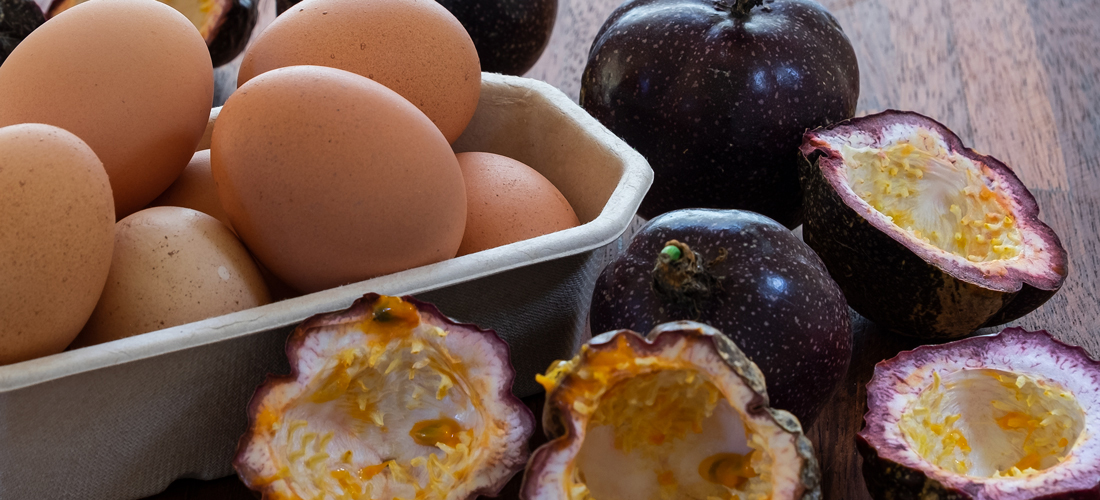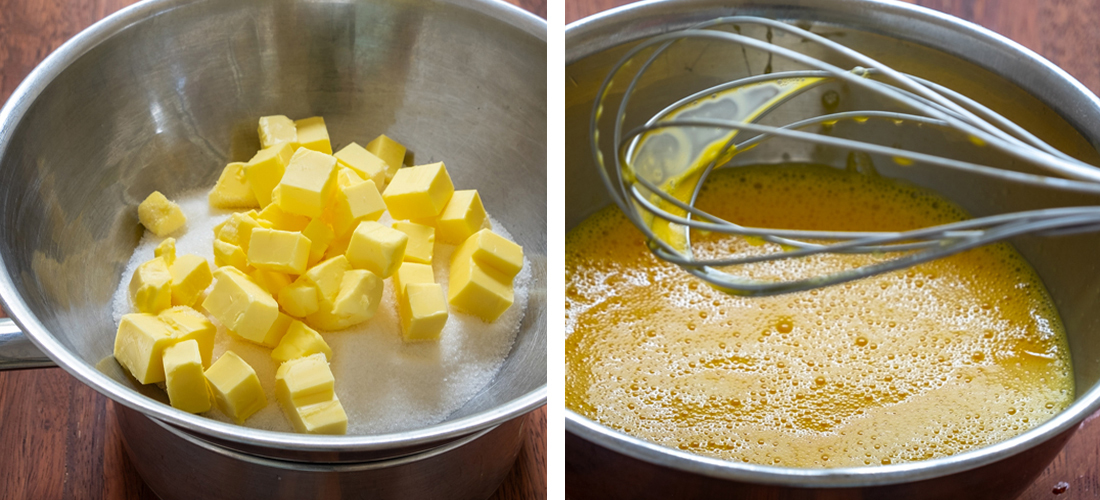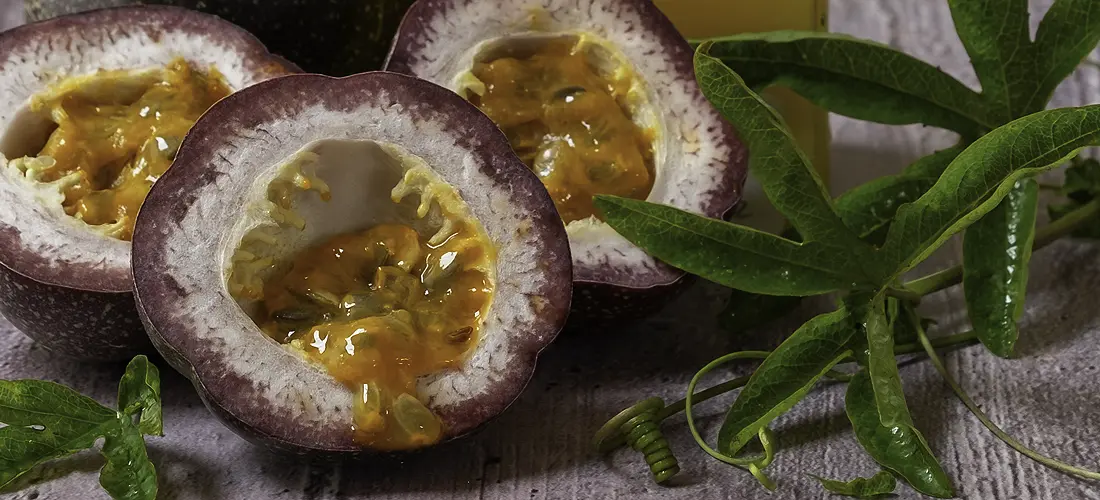Passionfruit Curd
- Fruit Cheeses, Butters & Curds

Fruit curds, with their creamy velveteen consistency, vibrant colour and touch of tang are utterly irresistible. It's springtime and there are plenty of eggs after the chooks winter moult and the deep purple passionfruit have ripened to perfection. The vine is laden, the fruit heavy and as the protective shell is split, an intense orange pulp with masses of black seeds, each surrounded by a small sac of precious juice is revealed with a gospel sign. Their taste, strong and tart with a penetrating fruity aroma marry perfectly with the rich melange of fresh home-grown eggs and creamy butter.
Whether it’s sneaking another spoonful of passionfruit curd right out of the jar, as the fridge light interrogates your etiquette or lavishingly spreading it on pikelets, cakes, over fresh fruit, meringues or your fave bakery item, an opened jar is quickly consumed. With a little practice and patience, a culinary elixir awaits you. And of course, licking the bowl and cooking utensils, so wickedly delicious, is mandatory!
- Preparation Time:
- 35 minutes
- Cooking Time:
- 15-20 minutes
- Quantity:
- 4 x200 ml jars
PREPARATION
Sterilise glass jars and have them hot, dry, and ready for the bottling stage.
Cut out wax paper discs to fit inside the preserving jars.

INGREDIENTS
- 150g
- Passionfruit pulp, approx 7 medium fruit
- 400g
- White sugar
- 230g
- Unslated butter
- 4
- Fresh eggs, whole
- 4
- Fresh egg yolks

METHOD
Fresh passionfruit pulp, eggs, sugar, and unsalted butter are cooked in a heat resistant bowl over a pan of gently simmering water, to produce a luscious consistency. My top 3 tips for successful curd are (1) strain the egg mixture, (2) keep stirring the mixture while it 's cooking and (3) never let it boil. For a more detailed explanation on how to make the perfect curd, refer to my article, Culinary Curd Capers.
Wash the passionfruit to remove any dirt and debris to prevent contaminating the mixture.
Cut the fruit in half horizontally, scoop out the pulp and seeds. Cut the butter into cubes so it melts quickly.
Place the sugar, cubed butter, and passionfruit pulp into a heatproof bowl-preferably stainless steel.
Place the bowl over a pot of gently simmering water and stir occasionally until the sugar has completely dissolved and butter is melted.
Place the whole eggs and egg yolks in a separate bowl and gently whisk until they are thoroughly combined. No egg white should be visible in the mixture. Do not overbeat the eggs.
Pour the egg mixture into the butter and sugar mixture and stir constantly over the heat until the curd thickens and lightly coats the back of a wooden spoon. Alternatively place a thermometer into the mixture and stir constantly, until the mixture reaches 83 degrees C. Do not overcook the mixture.
Remove from the heat and continue to stir for a few moments as the curd will continue to cook and thicken.
Pour the mixture through a fine sieve to remove the passionfruit seeds. Using a spoon, lightly push against the seeds to extract as much flavour as possible from the pulp that surrounds the seed.
Using a funnel and ladle pour into warm dry sterilised jars. Fill the jars to the brim, it shrinks and thickens as it cools. Completely cover the surface with melted paraffin wax and seal with transparent cellophane discs. Refer to my article Sealing Jars with Paraffin Wax for a step-by-step explanation.
-
Label and store in the fridge. Can be eaten immediately – no maturing time required.
Use within 6 weeks and check regularly for any contamination or mould.
NOTES

- Have warm sterilised jars and waxed discs cut to size and all ingredients weighed and ready before commencing.
- Unsalted butter is recommended when making fruit curds. Margarine can be used, however the flavour and texture will not be the same.
- Using a spatula, scrape down any undissolved sugar, that clings to the side of bowl, into the mixture. All the sugar must be completely dissolved before the eggs are added.
- Do not overbeat the eggs before adding to the mixture and stir constantly with a spoon or heat resistant spatula, not a whisk, as this aeration produces bubbles in the final curd. It’s not the end of the world and still tastes delicious but it will not be a show winner.
- Fruit curds should always be made in a heat resistant bowl over a pan of gently simmering water. Also known as cooking over a double boiler or bain marie, it disperses the heat gently across the bowl. This helps to thicken the egg mixture gently and prevents curdling, if it’s stirred continually and not overcooked! Do not allow the mixture to boil otherwise it will curdle and produce a lumpy curd. It’s still edible, however it will not have the characteristic creamy silken consistency.
- Curds thicken quite a lot as they cool and then later when they are stored in the fridge so, please don’t be tempted to overcook it.
- Made from a high proportion of eggs and butter, fruit curds are not suitable for room temperature storage. It’s better to make small quantities and store in small jars and always, always store in the fridge. Use within 3 months. I must admit it doesn’t last that long at our place once the jar is open.
- Sometimes called fruit butter because of its spreadability and now that traditional fruit butters are rarely made or commercially available. However. this is incorrect. Technically a fruit butter is made from sieved fruit pulp cooked with sugar to a stiff puree.
- Variations
- For those who like a bit more of a tang to their curd, the grated rind and juice of a lemon can be added to the butter and sugar and continue to follow the recipe.
- Any citrus flavour, orange, blood orange, mandarin, tangelo, lime, grapefruit, or lemon. Or try some combinations.
